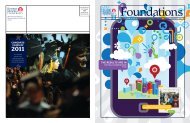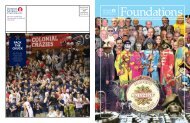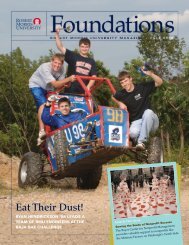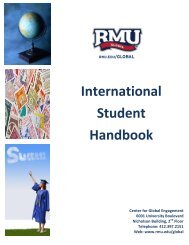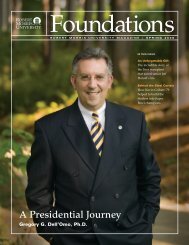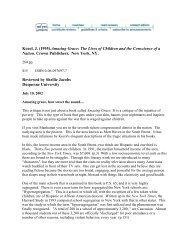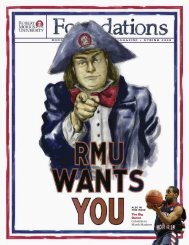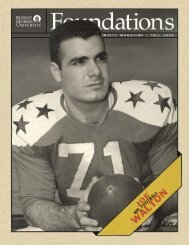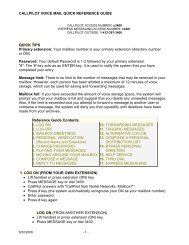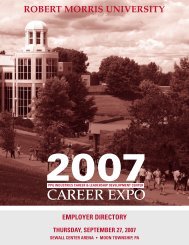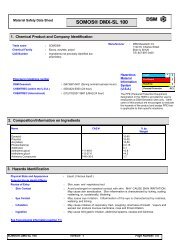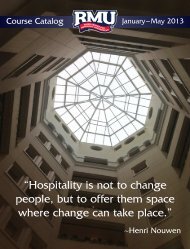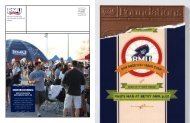Spring 2007 - Robert Morris University
Spring 2007 - Robert Morris University
Spring 2007 - Robert Morris University
- No tags were found...
Create successful ePaper yourself
Turn your PDF publications into a flip-book with our unique Google optimized e-Paper software.
touching the railing. Conditions were never quite right for<br />
Metcalf, though, and he is disappointed that he hasn’t had<br />
an opportunity to try out for the club.<br />
He did, however, get to experience another traditional<br />
observatory thrill: sledding on the auto road. The observatory<br />
is served by one private road that runs more than eight miles<br />
from the mountain’s base to the summit. When conditions<br />
are right, observers and interns coming off shift grab sleds,<br />
skis or cafeteria trays and hurl themselves down the slope.<br />
On one mid-March descent, Metcalf and a fellow observer<br />
slid down the mountain headfirst on plastic sleds, reaching<br />
estimated speeds of 15 to 30 miles an hour. The 35-minute<br />
ride left him bruised and aching – but exhilarated.<br />
REDISCOVERED PASSION<br />
Through his experience at the observatory, Metcalf has<br />
realized how well his RMU education prepared him for<br />
life in the field. <strong>Robert</strong> <strong>Morris</strong> <strong>University</strong> was the second<br />
attempt at a bachelor’s degree for Metcalf, who’s now 32.<br />
He attended college in Philadelphia in the mid-1990s,<br />
stopping just over a year shy of graduation. In between,<br />
he worked as a personal fitness trainer and lacrosse coach.<br />
After 10 years in the gym, Metcalf felt burned out and started<br />
looking to make a career change. He was familiar with RMU,<br />
but he was surprised to learn that the <strong>University</strong> offered an<br />
environmental science major.<br />
The strength of RMU’s environmental science program is<br />
in its breadth, Metcalf says. Graduate school is now almost<br />
a requirement in most fields, so RMU’s program exposes<br />
students to a broad range of topics within environmental<br />
science. “It helped me determine where I wanted to focus<br />
my attention,” he says.<br />
He also appreciated the chance to work one-on-one with his<br />
professors. The curriculum includes several one-credit field<br />
methods courses, which get students into the outdoors<br />
working side-by-side with faculty members.<br />
Another benefit, Metcalf found, was RMU’s emphasis<br />
on communications. “The people here know how to<br />
communicate in a business environment,” he says.<br />
“That’s useful for someone in science, because you’re<br />
either working with business people or they’re overseeing<br />
what you’re doing.”<br />
BEYOND THE MOUNTAIN<br />
Metcalf’s internship is winding down, and he’s turning his<br />
attention to life after the observatory. He and Shelley plan<br />
to move to New England, where he hopes to land a teaching<br />
position. “Science is the passion, but teaching has become<br />
an incredible drive for me,” says Metcalf, who supplemented<br />
his RMU degree with an education minor. He’s also<br />
considering graduate study for climatology or geochemistry.<br />
But his memories of the mountain won’t easily be eclipsed.<br />
“There are things up here I will never see anywhere else ever<br />
again,” Metcalf says. “I’m amazed by what is possible in the<br />
natural world. You can look at pictures of Mars and see some<br />
incredible things, but you don’t have to look into space to see<br />
some stuff that just drops your jaw. It’s right here.”<br />
WRITTEN BY JOSH EARL | PHOTOGRAPHY BY JON COTTON [MOUNT<br />
WASHINGTON OBSERVATORY] AND KEVIN COOKE | ADDITIONAL<br />
PHOTOGRAPHY PROVIDED BY ALAN METCALF ‘06<br />
ROBERT MORRIS UNIVERSITY FOUNDATIONS • 19



